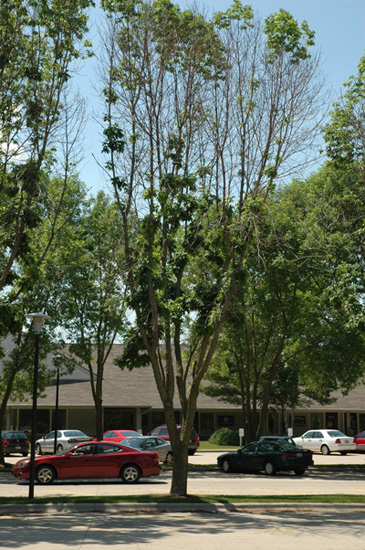Issue 14, August 22, 2011
My Tree is in Decline, Now What?
Most trees samples are immediately put into culture in order to isolate any fungal pathogens that may be infecting the vascular system of the tree, after they arrive at the U of I Plant Clinic. If the trees are negative for vascular, fungal pathogens, such as oak wilt (Ceratocystis fagacearum), Dutch elm disease (Ophiostoma ulmi), and Verticillium wilt (most often caused by Verticillium dahlia), the sample is carefully examined for signs of tree decline, such as:
- poor branch tip and stem growth (This is a sign that the tree may have been declining for several years, but our client is just now seeing symptoms of major decline)
- pale or yellow leaves
- delayed spring flush of growth
- leaf scorch (Lack of water can also cause leaves to scorch)
- smaller leaves than normal
- early leaf drop
- premature fall color
- dieback of the crown, twigs, and branches
- production of suckers on the branches or trunk
- abnormally large seed production (This also can be a normal response to certain weather conditions or a normal occurrence in some tree species)

Ash decline (photo by Nancy Pataky)
If the tree does show signs of decline, we will report this to our client, but it will be up to them to figure out what may be causing stress to their tree. Most clients would like to have a quick fix, but most of the time, it is not that easy. Here is a checklist of causes for decline:
- Have you had extremely high or low temperatures, such as rapid drop in temperature following a period of mild weather in the fall or spring?
- Has there been a fluctuation in soil moisture (drought or flooding)?
- Could there have been mechanical damage to tree roots from nearby construction, livestock, or environmental effects?
- Was there damage to the trunk or limbs due to lawn mowers, vehicles, vandalism, animals, or cracks (ex. sunscald, frost, and lightning)?
- Has the tree experienced adverse weather conditions such as strong winds or hail, diseases, insects, or herbicides at critical periods of plant development?
- Could there have been winter injury?
- Has there been changes in the soil near the tree such as compaction (parked cars), changes in soil drainage, or excessive or lack of soil moisture?
- Has there been soil fill or soil removed near the tree?
- Could the roots have been injured from excess deicing salt, pesticide, or fertilizer?
- Was the tree planted incorrectly?
- Was the tree planted too deeply? Is there volcano mulch or excess soil near the base?
- Did you provide the tree with the proper maintenance after planting?
- Is the tree planted in a site with poor soil structure and drainage (clay)?
- Have you had a soil test? Could there be a soil nutrient or mineral deficiency, imbalance, or improper soil pH?
- Could there be an obstruction that could restrict growing space for roots such as a sidewalk, driveway, patio, or septic tank?
- Do the roots appear to be girdled, poorly formed, or bound in twine (if above the ground)?
- Is there too much competition from surrounding trees or plants?
- Are the surrounding plants near the declining tree injured as well (ex. gas leak, environmental, or chemical injury)?
- Do you have comprehensive history of the pesticide use near the tree? Could a soil sterilant or biocide been used in a nearby gravel driveway or sidewalk?
If you need help with the evaluation of your tree contact your local U of I Extension office or contact a Certified Arborist.
Unfortunately, a stressed tree is more susceptible to disease, insects, and other secondary organisms.

Oak in decline, with a heavy infestation of oak gall (photo by S. Porter)
You will need identify what may be stressing your tree, and correct it, if possible. You can refer to the following report on disease, "Decline and Dieback of Trees and Shrubs" (Adobe PDF), for further information. In the meantime, we always recommend that you water the tree in times of drought greater than two weeks, fertilize with a general tree fertilizer in the fall, and prune and destroy any dead branches or leaves on or near the tree. It is especially important to remember to trim oaks in late summer and fall only, to avoid infection of oak wilt. (Stephanie Porter)
Author:
Stephanie Porter